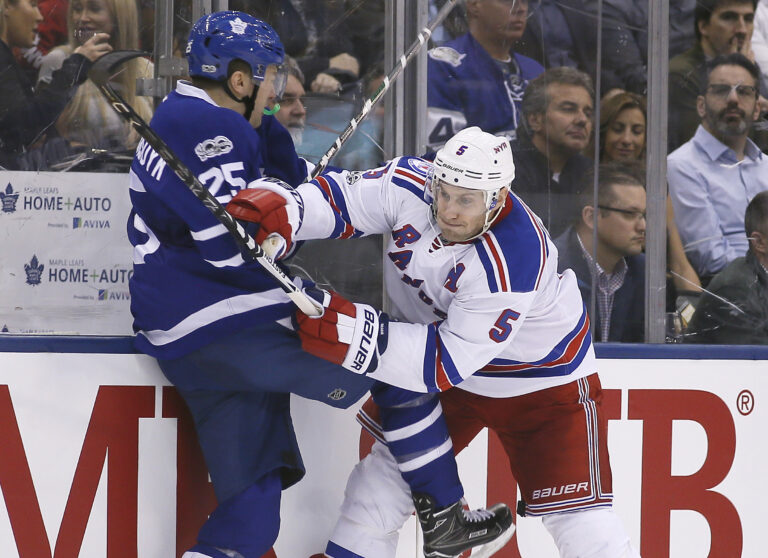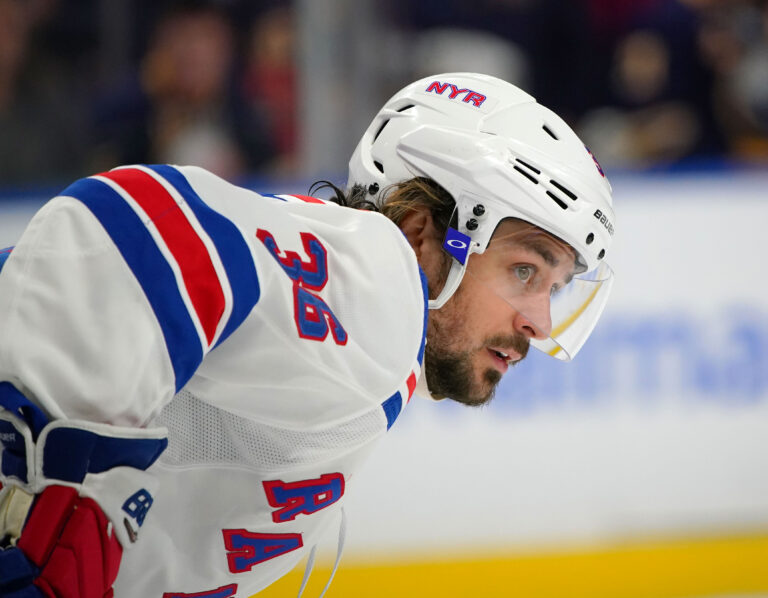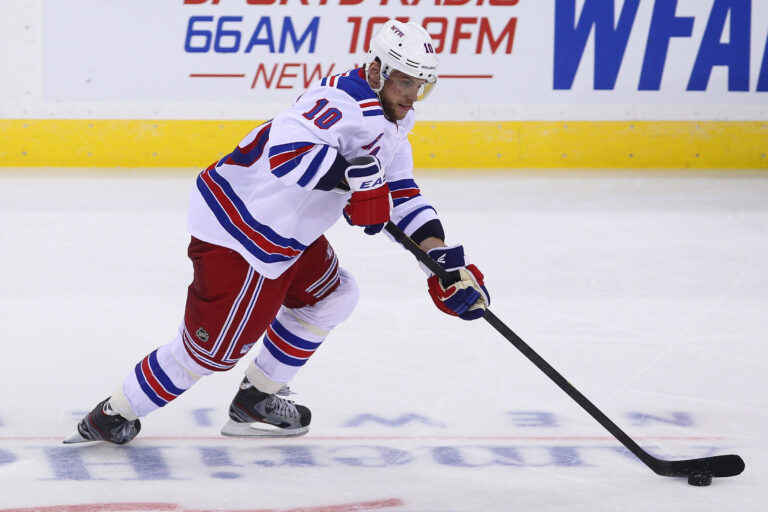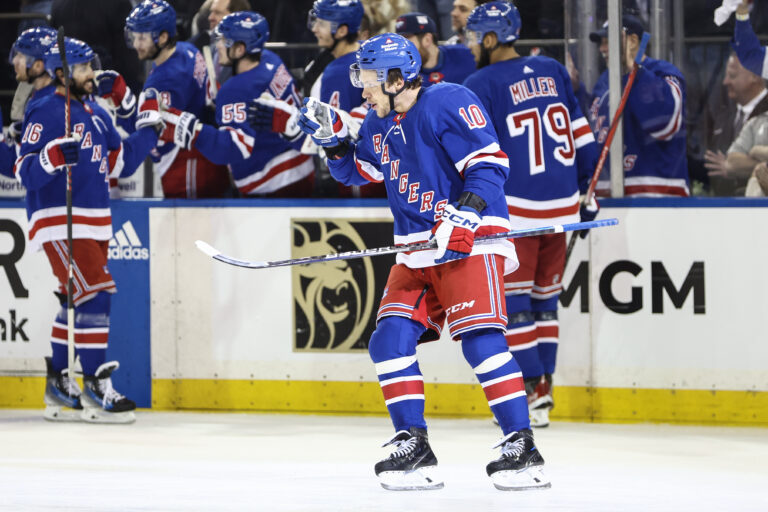New York Rangers best free-agent signings, from Lafleur to Panarin

Signing free agents is hockey’s version of buying a lottery ticket: You might wind up a big winner, but the odds aren’t necessarily with you.
From the 1970s to the present day, the New York Rangers have cashed more than a few winners. Some have been of the big-ticket variety, the kind of player everyone knows about. Others have been solid players who stepped up their games when they arrived at Madison Square Garden, while still others came from out of nowhere and turned into valuable contributors. Here’s a look at the 10 best free-agent signings in Rangers history:
Related: New York Rangers’ worst free-agent signings in history: Wade Redden leads the pack
10. A Flower Blooms on Broadway
The Signing: Rangers signed forward Guy Lafleur to a one-year contract
Date: Sept. 28, 1988
Why it mattered: Lafleur, one of the greatest players in NHL history, had retired in 1984 after 14 brilliant seasons with the Montreal Canadiens and was preparing for his induction into the Hall of Fame in September 1988 when he shocked the hockey world by deciding to attempt a comeback. Rangers GM Phil Esposito, a longtime Lafleur rival, hedged things a bit by calling it a “tryout,” but “Flower’s” performance at training camp showed that he still had something in the tank.
Lafleur wasn’t the star he’d been in Montreal, but he had flashes of his glory days during his one season in the Big Apple, including a four-assist performance against the Edmonton Oilers and the final hat trick of his NHL career against the Los Angeles Kings. But the biggest one came on Feb. 4, 1989, when he lit up the Forum in his first game back in Montreal. The crowd roared for No. 10 in blue as he scored twice and assisted on a third goal.
Related: New York Rangers worst trades in past 50 years, including Luc Robitaille twice
A goal in the season finale against the New York Islanders gave Lafleur 45 points (18 goals, 27 assists) in 67 games – excellent numbers for a 37-year-old who hadn’t played in the NHL for nearly four years.
Lafleur did the Rangers one more favor after becoming a free agent in the summer of 1989; he signed with his hometown Quebec Nordiques. Under the rules of that era, the Rangers received a fifth-round compensation pick in the 1990 NHL Draft — one that Espo’s successor, Neil Smith, turned into defenseman Sergei Zubov, a future Hall of Famer himself and the leading scorer on the Rangers’ 1994 Cup-winning team.
Related: New York Rangers best trades in past 50 years, including Mark Messier
9. A Terrific Two Years

The Signing: Rangers signed Michael Nylander to a three-year contract
Date: Aug. 10, 2004
Why it mattered: The only problem with Nylander’s time in New York was that it was too short.
The Rangers signed the Swedish center just before training camp in 2004, only to see the first season of his contract negated by the lockout that wiped out the 2004-05 season.
When play resumed in 2005-06, the 33-year-old found himself centering a line with Jaromir Jagr and Martin Straka. It was a match made in hockey heaven; Jagr set Rangers records that still stand with 54 goals and 123 points; he got plenty of help from Nylander, who had career highs in assists (56), points (79) and plus-minus (plus-31). The Rangers qualified for the Stanley Cup Playoffs for the first time since 1996-97 and reached the 100-point mark for the first time since winning the Stanley Cup in 1994.
Nylander was even better in 2006-07, putting up career highs across the board with 26 goals, 57 assists and 83 points. The Rangers again qualified for the playoffs, this time winning a round for the first time in a decade.
However, the season lost to the lockout meant that Nylander became a free agent in the summer of 2007, when he was coming off back-to-back career seasons. Though he was set to turn 35 just before opening night, the Washington Capitals swooped in and signed him to a four-year contract; he played just two seasons before retiring.
It wasn’t a coincidence that Jagr’s production fell off as soon as Nylander left, and he left for the KHL a year later.
These days, Nylander is best known for his hockey-playing sons — particularly Mitch, a high-scoring forward for the Toronto Maple Leafs.
Related: Where do New York Rangers rank regarding team statistics in salary cap era?
8. Dandy Dan

The Signing: Rangers signed defenseman Dan Girardi to a two-year contract
Date: July 1, 2006
Why it mattered: Girardi made a career out of putting his body in harm’s way.
The Rangers signed the undrafted free agent defenseman in the summer of 2006 and started him in the ECHL, but his gritty style (and some injuries on the blue line) got him to the NHL by midseason. He turned into a key member of the Rangers team that had the franchise’s longest run of success since the 1994 championship — they missed the playoffs once in his 11 seasons and got to the Stanley Cup Final in 2014.
Girardi did contribute offensively, but it was his willingness to hit and block shots that made him a Garden favorite. He was credited with at least 125 blocks in each of his final eight seasons with the Rangers and had more than 175 hits seven times in his 11 seasons with New York. Girardi averaged 22:15 of ice time in his 11 seasons with the Rangers, was an alternate captain and even earned a trip to the NHL All-Star Game in 2012.
But all those hits and blocks eventually took a toll. Girardi began to slow down in the later 2010s, and the Rangers bought out the final three seasons of his six-year contract in the summer of 2017. Tampa Bay signed him and he played two more seasons with the Lightning before retiring.
Girardi was the NHL’s all-time leader in blocked shots (1,954) when he hung up his skates; 1,691 of those came with the Rangers. Few players in team history have been more willing to sacrifice their body for the team.
Related: 10 most underrated New York Rangers since 2000
7. Trocheck Finds Next Level with New York Rangers

The Signing: Rangers signed center Vincent Trocheck to a seven-year contract
Date: July 13, 2022
Why it mattered: Trocheck is a good player who’s taken his game to another level since joining the Rangers.
The Pittsburgh native had been a solid middle-six center with the Florida Panthers and Carolina before Rangers GM Chris Drury brought him to New York two years ago. He said he made the decision to join the Rangers because he didn’t want to come to a team that didn’t have a chance to win every year.
Trocheck is a big reason the Rangers got to the Eastern Conference Final for the second time in three seasons last spring. Not only did he finish with a career-high 77 points and earn a spot in the NHL All-Star Game, he also led the Rangers in the postseason with 20 points in 16 games, scored his first career playoff overtime goal (a double-OT winner against Carolina) and set up two other OT tallies.
At 5-foot-11 and 187 pounds, Trocheck is small by NHL standards. But he more than makes up for any lack of size with his work ethic and intensity. Coach Peter Laviolette was so impressed with Trocheck’s effort last season that he played him an average of 21:27, fifth in the NHL among forwards. One reason he got so much ice time was his success in the faceoff circle; Trocheck was fifth among all players with a 58.7 winning percentage during the regular season, then won 57.8 percent of his draws in the playoffs.
But not only does Trocheck center the Rangers’ top offensive line, playing between Artemi Panarin and Alex Lafreniere, he’s also an excellent defensive center — arguably the defensive conscience of an offense-first trio. If his first two seasons are any indication, Trocheck’s average salary of $5.625 million is an incredible bargain.
Related: The Case For Rangers’ Vincent Trocheck being named to NHL Network’s top-20 centers List
6. From Norway to New York

The Signing: Rangers sign forward Mats Zuccarello to a two-year contract
Date: May 26, 2010
Why it mattered: “The Norwegian Hobbit” lost a name when he signed with the Rangers. He had been Mats Zuccarello Aasen while playing in Sweden and for his home country in the 2010 Winter Olympics, but the “Aasen” didn’t make the trip when he came to New York.
Zuccarello bounced between the Rangers and the AHL for his first three seasons before becoming a regular in 2013-14, breaking out with 19 goals and 59 points and contributing five goals and 13 points in the playoffs as the Rangers reached the Stanley Cup Final for the first time since winning it all in 1994.
The 5-foot-8 forward soon became a crowd favorite, winning the Steven McDonald Extra Effort award twice. He was named an alternate captain in 2017, scored his 100th NHL goal on March 12, 2018, and became the ninth player in Rangers history to lead the team in scoring for three consecutive seasons.
But when the Rangers struggled in 2018-19, management decided to rebuild — and the 31-year-old Zuccarello was among those who were shipped out. He was dealt to the Dallas Stars on Feb. 23, 2019, though he played just two games before an upper-body injury ended his season. He’s played the past five seasons with the Minnesota Wild. But his 113 goals and 352 points in 509 games are a terrific contribution from a player no one knew much about before his arrival.
Related: Top 10 all-time best United States-born players in New York Rangers history
5. Sweet Swedes
The Signing: Rangers signed center Ulf Nilsson and forward Anders Hedberg to two-year contracts
Date: March 20, 1978
Why it mattered: Free agency within the NHL was still years away in 1978. But poaching talent from the rival World Hockey Association was perfectly OK, and that’s what GM John Ferguson did in March 1978 when he announced that two of the WHA’s biggest stars, Swedish linemates Nilsson and Hedberg, would be heading to the Big Apple for the 1978-79 season.
The two, along with left wing Bobby Hull, had terrorized WHA goalies for years with the Winnipeg Jets, so the news left Rangers fans salivating. Hedberg scored at least 50 goals and finished with 100 points in each of his four WHA seasons. Nilsson averaged 121 points in his four WHA seasons and never had fewer than 76 assists.
Neither came close to those totals in the NHL, but both were fine players who keyed the Rangers’ run to the 1979 Stanley Cup Final.
Hedberg had three straight 30-goal seasons and led the Rangers in scoring in 1978-79. A knee injury limited him to four games in 1981-82, but he had at least 20 goals in each of his six seasons before retiring in 1985.
Nilsson was averaging well over a point a game in his first season before he sustained a broken ankle caused when he caught a rut in the ice at the Garden as he was hit by Islanders defenseman Denis Potvin (he absolved the future Hall of Famer of any blame for the injury, but the “Potvin Sucks” chant lives on 45 years later). Nilsson also missed the entire 1981-82 season because of a knee injury sustained playing for Sweden in the 1981 Canada Cup. He played just 10 games in 1982-83 before retiring with 169 points in 170 NHL games — and one of the biggest “what if” clouds in Rangers history.
Related: 5 alternate jerseys the New York Rangers should bring back
4. Grabbing Gabby

The Signing: Rangers signed forward Marian Gaborik to a five-year contract
Date: July 1, 2009
Why it mattered: Gaborik figured in one of the most embarrassing games in Rangers’ history — he became the first player in 11 years to score five goals in a game when he did it for the Minnesota Wild against Henrik Lundqvist on Dec. 20, 2007. That big night was part of a 42-goal season, one that convinced the Rangers to sign him when free agency opened in July 2009, even though he’d missed all but 17 games in 2008-09 while recovering from hip surgery.
Gaborik did just what the Rangers brought him to New York to do — score. He was fifth in the NHL in 2009-10 with 42 goals, then scored 41 in 2011-12 to help them finish first in the Eastern Conference. He was voted a First-Team All-Star and scored what is still the latest overtime goal in Rangers history, connecting at 14:41 of the third overtime in Game 5 of the conference semifinals against the Washington Capitals; the 2-1 win keyed their trip to the conference final.
But the Rangers lost that series to the New Jersey Devils, and coach John Tortorella was unhappy with the play of many of his veterans, including Gaborik — although it was revealed after the playoffs that he’d been playing with a torn labrum in his right shoulder.
Gaborik had successful surgery and was ready to go when the lockout-shortened 2012-13 season began in January. But Tortorella hadn’t forgotten his unhappiness from the previous spring. Gaborik’s ice time diminished, as did his scoring numbers, and he sometimes found himself on the fourth line.
The Rangers sent Gaborik to the Columbus Blue Jackets at the 2013 trade deadline, but he exacted his revenge on the Rangers a year later after being traded to the Los Angeles Kings. Gaborik’s 14 goals led the Kings as they won the Stanley Cup for the second time in three seasons; the last two were game-tying third-period tallies in their five-game victory over the Rangers in the Final.
Despite his disappointing finish with the Rangers, Gaborik finished his time in New York with 115 goals and 229 points in 255 games. Tortorella was fired after the 2012-13 season — and it would have been interesting to see what Gaborik would have done under his replacement, Alain Vigneault.
Related: 6 Unanswered Rangers questions before 2024-25 season, including Matt Rempe’s long-term role
3. A “Great” Day

The Signing: Rangers sign center Wayne Gretzky to a two-year contract
Date: July 21, 1996
Why it mattered: Hockey’s greatest player playing his home games at The World’s Most Famous Arena. Sounds like a match made in heaven.
Of course, it wasn’t the 1980s-model Gretzky that the Rangers were getting when they signed “The Great One” in the summer of 1996. But even a 35-year-old Gretzky was still a force to be reckoned with, especially because he was rejoining his longtime Edmonton Oilers teammate Mark Messier.
The Gretzky-Messier tandem carried the Rangers to the Eastern Conference Final in 1996-97, which turned out to be their only season together in New York. No. 99 was No. 1 in the NHL with 72 assists, led the Rangers with 97 points, was voted a Second-Team All-Star and piled up 20 playoff points (including a first-round hat trick against the Florida Panthers) before the Philadelphia Flyers bounced them in five games.
Gretzky led the NHL in assists again in 1997-98 with 67 and repeated as a Second-Team All-Star. But with Messier signing with the Vancouver Canucks as a free agent, they finished 15 points out of a playoff berth. They were out of the playoff race for most of 1998-99, and as the end of the season approached, Gretzky decided he’d had enough. On April 16, two days before the end of the season, he announced he would retire after the Rangers’ final game two days later.
Appropriately, his last NHL point was an assist — one that came on the Rangers’ lone goal in a 2-1 overtime loss to the Pittsburgh Penguins, who then lined up and shook his hand like it was the end of a playoff series. After the teams left the ice, Gretzky came back out for a solo skate — “I made a lot of curtain calls, but the fans wouldn’t stop cheering,” he said. “I cried; I broke down a couple of times.”
The Great One is still the Greatest One when it comes to goals, assists and points. Those numbers include the 57 goals and 249 points in his 234 games as a Ranger. His big regret was that he didn’t win the championship he’d hoped for in New York.
Related: Rarest Rangers sweaters in franchise history, including Wayne Gretzky
2. “Gravy” Train Rolls In
The Signing: Rangers sign forward Adam Graves to a five-year contract
Date: Sept. 3, 1991
Why it mattered: Chalk up one for Neil Smith.
Before joining the Rangers as GM in 1989, Smith had worked for the Detroit Red Wings. One of the players he scouted was Graves, who was selected by Detroit in the second round of the 1986 NHL Draft. But the Wings traded Graves to Edmonton in November 1989, and he was part of the Oilers’ championship team the following spring.
However, Smith never forgot Graves, and when he became a Group I free agent after the 1990-91 season, the Rangers signed him to a five-year contract, giving up forward Troy Mallette as compensation. Graves was given No. 11, but quickly shifted to No. 9 after the Rangers acquired former Edmonton teammate Messier a month later.
Coach Roger Neilson put Graves on Messier’s left wing, and he began filling the net. After seasons of 26 and 36 goals, “Gravy” broke the Rangers’ single-season goal-scoring record with 52, then piled up 10 more in the playoffs; the last one came in Game 7 of the Final and helped the Rangers end their 54-year championship drought.
Graves’ style of play was simple but effective — get to the front of the net and make life miserable for opposing goalies. Most of the 280 goals he scored in 10 seasons with the Rangers didn’t travel very far. But off the ice, he might have been even more valuable for what he did for the team and the community. Though on the ice, he was tough as nails, scoring goals and protecting teammates so well that the Rangers retired his No. 9 on Feb. 3, 2021. Wway from the rink, he was humble, caring and kind — and still is.
1. The Breadman Cometh

The Signing: Rangers sign forward Artemi Panarin to a seven-year contract
Date: July 1, 2019
Why it mattered: Panarin was an instant hit in the NHL after arriving with the Chicago Blackhawks from Russia as an undrafted free agent, winning the Calder Trophy in 2015-16 and being named a Second-Team All-Star the following season. Despite that, the Hawks traded him to the Columbus Blue Jackets in the summer of 2017, only to see him continue to pile up points during the following two seasons.
Panarin had plenty of suitors when he became an unrestricted free agent in the summer of 2019, but reportedly turned down more money from at least one other team to sign a seven-year, $81.5 million contract with the rebuilding Rangers.
Talk about money well spent!
Panarin’s arrival jump-started the rebuild the Rangers had announced before the 2018 trade deadline, and he’s been a major factor in their two trips to the Eastern Conference Final during the past three seasons. “The Breadman” delivered career highs of 49 goals and 120 points last season, helping the Rangers win the Presidents’ Trophy as regular-season champs; the 120 points are the second-highest single-season total in Rangers history, trailing only Jagr’s 123 in 2005-06.
He is the only player in team history to break the 90-point mark four times (the only time he missed was the Covid-shortened 2020-21 season), and he’s one of just five Rangers to score as many as 49 goals in a season. His 1.32 points per game is the most in the Rangers’ 98-year history, and he reached 400 points faster than anyone in team history. Few free-agent signings in NHL history have paid off like this one.
Related: Rangers’ Artemi Panarin named one of best wings in hockey by NHL Network analyst
More About:New York Rangers Analysis

